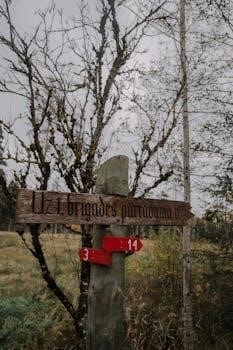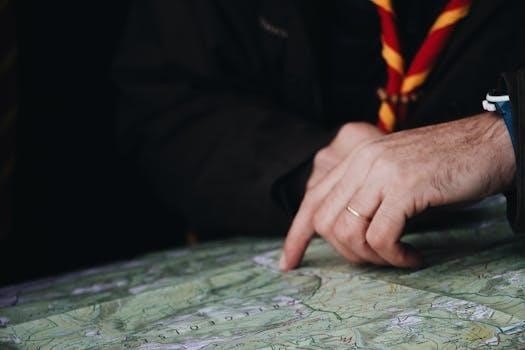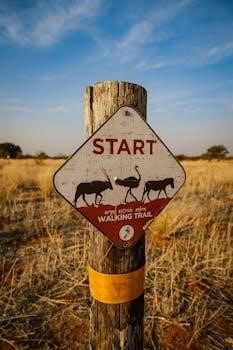
Trail Guide to the Body by Andrew Biel⁚ A Comprehensive Guide
Trail Guide to the Body, authored by Andrew Biel, is an award-winning, comprehensive resource for healthcare professionals and students. It provides a hands-on approach to learning musculoskeletal anatomy and palpation skills. This book is celebrated for its detailed illustrations and clear, accessible explanations.
About the Author, Andrew Biel
Andrew Biel is a licensed massage practitioner and the author of the renowned Trail Guide to the Body. His extensive experience in manual therapy and bodywork has shaped his approach to teaching musculoskeletal anatomy. Beyond writing, Biel enjoys a life with his wife, Lyn Gregory, and their daughter, Grace Amalia, often spending time tending to goats and chickens. He has a deep understanding of the body’s structures, which is reflected in his ability to communicate complex concepts in an easy-to-understand manner. His passion for teaching palpation skills and making anatomy accessible to a wide audience is evident in the design and content of his book. His work has significantly impacted the education of countless healthcare providers, guiding them to master the art of palpation and confidently locate muscles, bones, and other body landmarks. Andrew Biel’s dedication to his craft and his commitment to educational excellence make him a respected figure in the field. His unique blend of practical experience and teaching ability has made Trail Guide to the Body a staple in many healthcare programs.
Core Concepts of Trail Guide to the Body
At the heart of Trail Guide to the Body lies the concept of palpation as a fundamental skill for healthcare professionals. The book emphasizes the necessity of locating muscles, bones, and other body landmarks before assessing or treating them. It focuses on a hands-on approach to learning, encouraging readers to actively engage with the material and practice palpation techniques. The core concepts include a detailed exploration of the musculoskeletal system, providing readers with a deep understanding of the origins, insertions, and actions of muscles. The guide also delves into the different types of connective tissues, explaining their roles and functions. Furthermore, the book highlights the importance of visual learning, incorporating detailed illustrations to enhance the reader’s comprehension of anatomical structures. By integrating visual and kinesthetic learning, the book makes complex concepts more accessible and memorable. The focus on practical application ensures that readers develop the necessary skills to confidently navigate the body’s landscape, making it a valuable resource for students and practitioners alike. The book’s structured approach facilitates active learning through engaging questions and clear instructions for practical application.
Focus on Palpation Skills
Trail Guide to the Body places a significant emphasis on developing palpation skills, recognizing that the ability to accurately locate and identify anatomical structures is crucial for effective assessment and treatment. The book provides detailed guidance on how to palpate various muscles, bones, and ligaments, ensuring readers can confidently navigate the body’s complex terrain. It breaks down the process into manageable steps, using clear instructions and visual aids to facilitate learning. The text encourages active participation, prompting readers to practice palpation techniques on themselves and others to improve their tactile sensitivity. Through hands-on exercises, readers develop the ability to distinguish between different tissues and identify specific anatomical landmarks. This focus on tactile learning is reinforced by the book’s structure, which integrates practical application with theoretical knowledge. The palpation skills section serves as a foundation for further learning, enabling students and professionals to enhance their understanding of the human body. Moreover, the book offers tips for improving palpation sensitivity, helping readers refine their technique and increase their accuracy. This practical focus ensures that the knowledge gained is directly applicable in clinical settings.

Illustrations and Visual Learning
A key strength of Trail Guide to the Body lies in its exceptional use of illustrations to enhance visual learning. The book features detailed, high-quality sketches and diagrams that provide a clear and comprehensive view of the musculoskeletal system. These visuals are not merely decorative; they are an integral part of the learning process, allowing readers to grasp complex anatomical concepts more easily. The illustrations are carefully designed to show the precise location of muscles, bones, and other structures, making it simpler to locate them during palpation. The visual aids also help readers understand the relationships between different anatomical parts, promoting a deeper understanding of the body’s interconnectedness. Furthermore, the book often includes multiple views of the same structure, from different angles, allowing for a more complete mental picture. This approach is particularly beneficial for visual learners, who can internalize information more effectively through imagery. The illustrations are paired with clear, concise text, providing a balanced learning experience that caters to various learning styles. The visual clarity and artistic detail make the study of anatomy engaging and memorable. The integration of visual learning supports the development of both theoretical knowledge and practical skills.
Editions and Publication History
Trail Guide to the Body has a rich publication history, reflecting its enduring popularity and relevance in the field of manual therapy. The first edition of this acclaimed book was published in 1997, marking the beginning of its journey as a trusted resource for healthcare professionals. Since then, it has undergone several revisions and updates, with each new edition incorporating the latest anatomical knowledge and feedback from practitioners and students. The sixth edition, published by Books of Discovery, is currently available, continuing the legacy of previous editions. This latest version builds upon the strengths of earlier editions while also offering new features and enhancements. The book’s publication has been a collaborative effort involving author Andrew Biel and illustrator Robin Dorn, ensuring a consistent blend of accurate anatomical information and high-quality visuals. Over the years, Trail Guide to the Body has been published in multiple countries and languages, extending its reach to a global audience. Its widespread use and continued evolution underscore its significance as a foundational text in manual therapy education. The book’s enduring success is a testament to its comprehensive approach and practical application, making it a staple in the libraries of many healthcare professionals.
Target Audience and Applications
Trail Guide to the Body primarily targets students and practitioners in various healthcare fields who need a deep understanding of musculoskeletal anatomy and palpation skills. This includes, but is not limited to, massage therapists, physical therapists, athletic trainers, chiropractors, and osteopathic physicians. The book serves as an essential resource for those learning or practicing manual therapies, providing a practical, hands-on approach to locating muscles, bones, and other anatomical structures. The applications of the knowledge gained from this book are broad, ranging from assessment and diagnosis to treatment and rehabilitation. It is used in educational settings as a core textbook for anatomy and palpation courses, and it also serves as a valuable reference in clinical practice. The palpation techniques taught in the book are fundamental for effective manual therapy interventions, allowing practitioners to accurately identify and address musculoskeletal dysfunctions. Moreover, the book’s detailed illustrations and clear instructions facilitate both learning and practical application of anatomical knowledge. The text is also used by movement professionals and personal trainers who need a functional understanding of the body. Overall, Trail Guide to the Body is a versatile tool that enhances the skill set of professionals across various disciplines.
Online Resources and Study Tools
Trail Guide to the Body is not just a textbook; it’s a comprehensive learning system supported by a range of online resources and study tools. Purchasers of the book gain access to an exclusive online repository, designed to enhance understanding and retention of the material. These resources typically include palpation videos, which demonstrate the techniques described in the book, allowing for visual and kinesthetic learning. Overlay images are also often provided, aiding in the visualization of anatomical structures beneath the skin. Interactive mobile apps offer another avenue for learning, providing a convenient and engaging way to study on the go. These apps may include quizzes, flashcards, and 3D models, further reinforcing anatomical knowledge. The online resources are designed to be user-friendly and easily accessible, catering to a variety of learning styles and preferences. They are also regularly updated, ensuring that students and practitioners have access to the most current and relevant information. By integrating these online tools with the physical book, Trail Guide to the Body offers a multi-faceted learning experience that is both effective and engaging, helping users to master the complexities of musculoskeletal anatomy and palpation. Furthermore, the availability of these resources ensures that users can study wherever and whenever they need them.

Customer Reviews and Feedback

Trail Guide to the Body has garnered overwhelmingly positive customer reviews and feedback, consistently praised for its clear and practical approach to learning musculoskeletal anatomy. Many users highlight the book’s exceptional illustrations as a key factor in its effectiveness, noting that they make complex anatomical structures easy to visualize and understand. The hands-on approach and palpation techniques described in the book are frequently cited as valuable assets for students and practitioners alike. Reviewers often comment on the book’s user-friendly format and engaging style, which makes learning both interesting and memorable. The inclusion of online resources and study tools is another aspect that receives high praise, with users appreciating the additional support these materials provide. Some reviewers specifically mention how the book has helped them improve their palpation skills and enhance their understanding of the body’s structure. Others express satisfaction with the way the book facilitates active reading and encourages engagement with the material. Overall, customer feedback consistently reflects the book’s effectiveness as a learning tool, making it a highly recommended resource for anyone studying or working in the field of bodywork and related healthcare professions. The book’s ability to translate complex information into easily digestible content is a recurring theme in the reviews, underlining its value as an educational tool.
Availability and Purchasing Options
Trail Guide to the Body by Andrew Biel is widely available through various channels, making it easily accessible to students and professionals. The book can be purchased from major online retailers like Amazon, where both new and used copies are often listed. Additionally, it is available through the publisher’s website, Books of Discovery, offering a direct purchasing option. Many online bookstores also stock the book, providing a range of prices and conditions, including options for buying or renting. For those who prefer a physical bookstore experience, it is often found in college bookstores and specialized retailers that cater to health and wellness professionals. The book is also available in various editions, including paperback and softcover, with some retailers offering special deals or bundled packages. Furthermore, ebook versions are available for those who prefer digital formats. The option to buy or rent provides flexibility for students with varying needs and budgets. It is also possible to find used copies through online marketplaces and independent sellers. This widespread availability ensures that individuals around the world have access to this valuable resource for learning musculoskeletal anatomy and palpation skills. The presence of multiple purchasing avenues underscores the book’s popularity and continued relevance in the field.
Impact on Healthcare Professionals
Trail Guide to the Body by Andrew Biel has had a profound impact on healthcare professionals across various disciplines. It is considered a gold standard textbook for teaching surface anatomy and palpation skills, essential for accurate assessment and treatment. The book’s detailed illustrations and clear explanations empower practitioners to confidently locate muscles, bones, and other anatomical structures. This is crucial for massage therapists, physical therapists, athletic trainers, chiropractors, and other bodywork professionals. By enhancing their palpation abilities, the book helps these professionals provide more effective and targeted care to their patients. Many healthcare practitioners consider it an essential reference for their daily practice, using it as a quick guide when assessing clients. The hands-on approach of the book encourages active learning and practical application, making it a valuable tool for both students and seasoned professionals. Its focus on palpation skills directly translates to improved clinical outcomes and client satisfaction. Furthermore, the book’s emphasis on understanding the relationship between muscles, bones, and other tissues enhances the healthcare professional’s comprehensive understanding of the human body. The book’s influence extends globally, with its translations and distributions in many countries. Its effectiveness in improving patient care ensures its continued relevance within healthcare.
